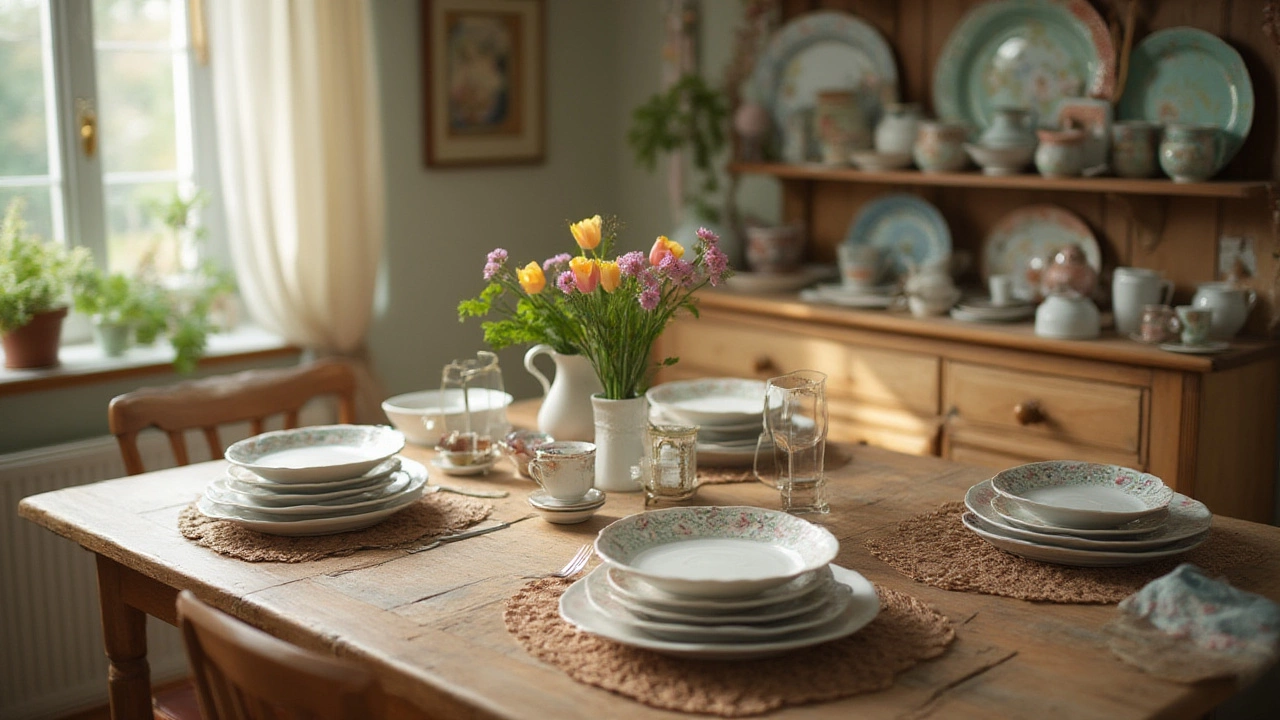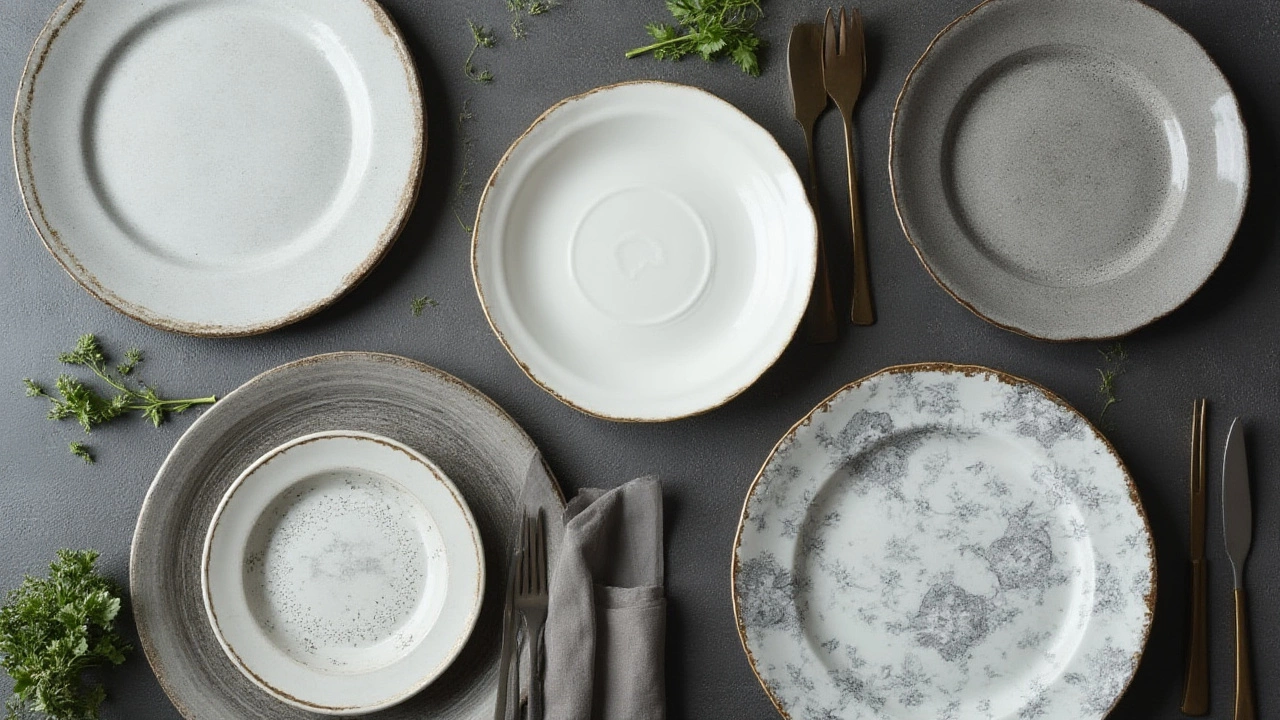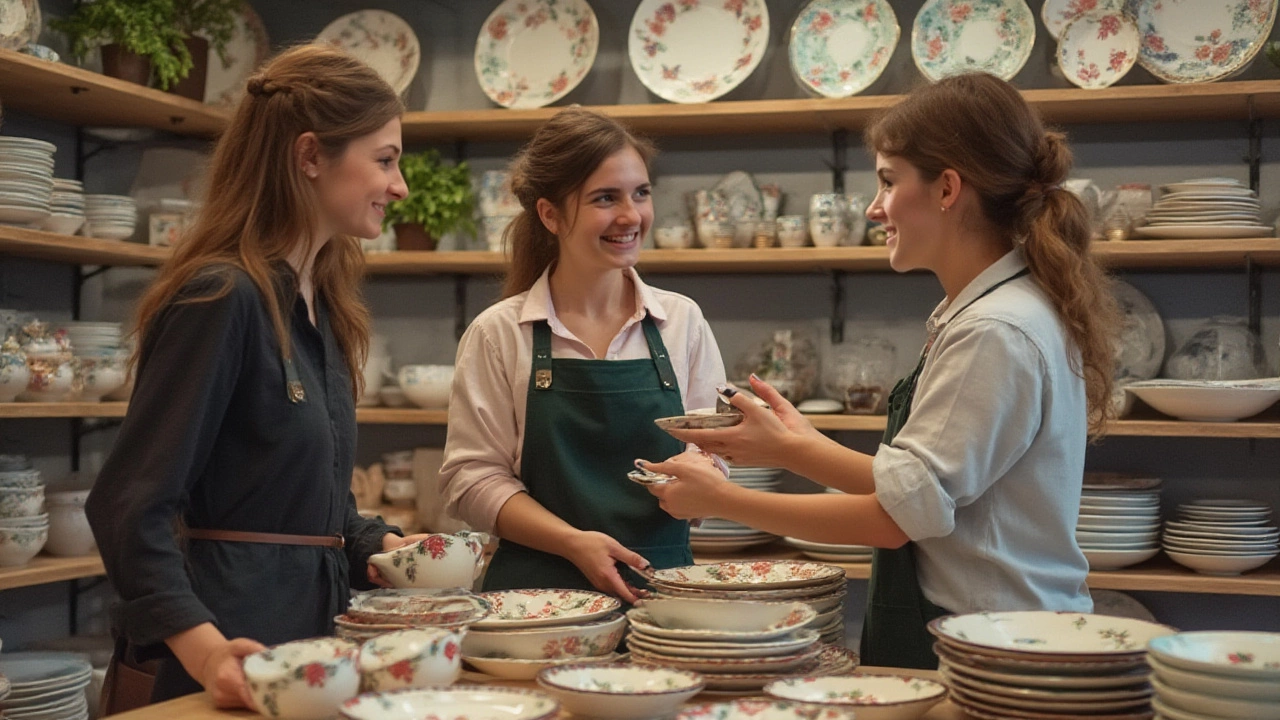Types of Kitchen Plates: Names, Uses, and Essential Buying Guide
 Jul, 8 2025
Jul, 8 2025
Did you know that dinner plates didn’t become common until the 18th century? Before that, people ate off trenchers—slabs of stale bread, or sometimes even wood. The word ‘plate’ seems pretty basic until you start looking around your kitchen and realize not every flat thing you eat off is just called a plate. Walk through any home store, and suddenly, you’re bombarded by salad plates, dessert plates, chargers, coupe plates—who knew eating at home was this complicated?
The Simple Plate: Names and Everyday Uses
Peeking inside the average kitchen cabinet, you’re likely to spot ‘dinner plates’ first. These are the everyday workhorses—flat, round, and typically about 10 to 12 inches across. If you sit down for lunch or dinner, this is the plate you’re grabbing. But dinner plates are just the tip of the iceberg. There’s a whole line-up of plates, each designed for specific foods or moments in the meal.
Salad plates are next in line. These are smaller than dinner plates—usually 7 to 8 inches across. A lot of homes use them for more than just salad. Breakfast toast, a sandwich, a slice of leftover birthday cake—if it’s a snack, it lands on the salad plate. Then you’ve got dessert plates, which are pretty much the same size as salad plates but marketed for sweets. It’s not unheard of to find people using them interchangeably, despite what some brands or expert hosts insist. Dessert plates often come in fancier designs, making them show-stoppers on special occasions.
Soup plates might throw you off. These have a wider rim than a classic bowl, letting you pile on toppings or dunk bread without risking an accident. Some call them ‘soup bowls,’ but true soup plates look more like a plate with a gently sloping, shallow center. Pasta plates fit in this shallow category too, curving up just enough to trap saucy spaghetti or creamy risotto.
Then come bread and butter plates—tiny guys, just 6 to 7 inches wide. Every formal table setting gives one a spot at the top left, just for your roll or croissant. And if you like to go all out, you might meet the charger plate. These big decorative plates, also known as ‘service plates,’ never touch food directly. Instead, they anchor each place setting from the first to the last course, protecting the tablecloth and adding a pop of style.
Confused yet? Here’s a handy breakdown of popular kitchen plate names and typical sizes:
| Plate Type | Typical Size (inches) | Main Use |
|---|---|---|
| Dining Plate | 10-12 | Main meal servings |
| Salad Plate | 7-8 | Salads, snacks, breakfast |
| Dessert Plate | 7-8 | Desserts or small bites |
| Bread & Butter Plate | 6-7 | Bread, rolls, side items |
| Soup Plate | 9-10 | Soups, brothy pasta dishes |
| Pasta Plate | 9-11 | Pasta, stew, saucy dishes |
| Charger Plate | 12-14 | Decorative, under-lay only |
Different countries have different names too. In the UK and Australia, ‘side plate’ refers to what Americans call a bread plate. The French say ‘assiette’ for a basic plate of any kind, but get more specific with ‘assiette à dessert’ or ‘assiette creuse’ for desserts and soups. The variety can be dizzying, but each serves a real purpose once you start noticing how they’re used at dinners and restaurants.

Not Just Plates: Materials, Styles, and Handy Facts
You might think all plates are just round, white, and ceramic, but plates come in all sorts of shapes, colors, and materials. There’s a reason you find plates made from porcelain, stoneware, melamine, glass, bamboo, and even metal. When it comes to strength and resilience, porcelain is the classic choice. It’s what most restaurants use since it can handle daily wear and tear while staying chip-resistant and looking sharp. For home, you might choose stoneware—slightly heavier, more rustic, and with a playful range of glazes. Stoneware plates are ideal if you like a cozy kitchen vibe yet want something you can toss in the dishwasher.
Melamine isn’t just for al-fresco picnics or kids’ meals. Modern melamine is sturdy and brightly patterned—a favorite for poolside dining or busy families. Durability comes at a cost, though: melamine shouldn’t go in the microwave, or it can warp or leach chemicals.
Glass plates have made a trendy comeback, especially for color-themed parties or when you want your food to look artistic on the table. They do scratch easily but look stunning under candlelight. Bamboo and sugarcane fiber plates have answered the call for eco-friendly options. These compostable, one-time-use plates are popping up at weddings and barbecues since they look far better than wimpy paper plates and break down without a fuss.
If you want something truly special, bone china takes the cake. It’s lighter than porcelain, slightly translucent, and is what you’ll see in high-end restaurants serving fancy tasting menus. Bone china can be expensive (it’s made with ash from animal bones, for a start), but it’s surprisingly strong and usually reserved for special occasions. For a fun stat, a recent consumer survey found that 58% of people picked their plates for ‘how nice they look’ over ‘how practical they are.’ No wonder so many kitchen shelves overflow with mismatched pieces that caught someone’s eye!
Plate shapes are just as varied. Round is classic, but square and rectangular plates are popular in Japanese and modern Western kitchens. They let chefs get creative, arranging food in artful ways. Coupe plates ditch the rim for a clean, edge-to-edge look—great if you want Instagram-worthy presentation.
If you’re into trivia, here’s one: the oldest known plate found by archeologists dates back to the ancient Greeks, over 2,500 years ago. Early plates were often metal—a sign of wealth—or just hollowed wood. Paper plates, a total modern invention, didn’t appear until the late 19th century when the push for hygiene created a market for disposable wares.
Stacking plates right saves space and cuts down on chips. Always stack same-size plates, with soft liners or paper towels between them if you want them to stay pristine. And no, you don’t need to buy entire matched sets. Mixing plain and decorated plates creates a table that feels casual but put-together, showing personality while skipping the pressure of perfect etiquette.
"Dinnerware should suit both the style of dining and the mood you want to create. Pick plates for practicality and pleasure—the best ones will serve both." — Julia Reed, food writer and tableware expert
Before you buy, ask yourself: do they fit in my dishwasher? Are they heavy? Will the colors clash with food? Bright red plates, for example, tend to dull the appearance of food—chefs usually recommend white or neutral shades so the meal pops. If you microwave leftovers a lot, avoid plates with metallic trims or gold accents—these can zap and even cause sparks.
Kids in the house? Go for thick melamine (with suction cups, if you’ve got a wild preschooler). If you love hosting, charger plates and matching dessert plates can make every meal feel like a party. And if storage is tight, choose lighter, stackable plates—even bamboo is a smart choice for easy-to-carry options or camping.
Don’t ignore care instructions. Some fancy designs are only dishwasher safe on the top rack, and matte glazes can absorb stains. A tip: if your plate shows grayish fork marks, a paste of baking soda and water usually scrubs it out, saving you from throwing out a perfectly good plate.

Choosing the Right Plates for Your Kitchen
Ever stood in the dinnerware aisle, frozen in indecision? You’re not alone. Picking the right kitchen plates comes down to your eating habits, storage space, and style preferences. The big debate usually comes down to sets vs. singles. Sets keep things uniform but can get pricey or too formal for daily life. Mixing and matching, on the other hand, brings personality to your table and is often more economical if you buy plates as you need them.
Look for plates that feel good in your hand—not too heavy, not so light they’re likely to tip over. Run a finger around the edge: smooth rims mean comfort. Flat plates stack better and save cupboard space, but a plate with a slight well or rim is less likely to let sauce escape. Pay attention to diameter. Oversize plates look impressive but might not fit your microwave or dishwasher. If you live in a small space, the classic 10-inch dinner plate works for almost everything.
Material is another biggie. If you stick your plates in the microwave often, avoid anything with metal trim. Dishwasher-safe labels are your friend if you hate washing up. Stoneware and porcelain are great everyday options. Melamine or bamboo works when you want something unbreakable or portable. Purists (and some chefs) insist on bone china for special occasions. These are lighter but pricier, reserved for holidays and impress-the-parents dinners.
Don’t underestimate the psychology of color, either. Lots of people forget that heavy patterns or bold colors can actually make food look odd or less appetizing. That’s why restaurant plates are usually plain white. A plain backdrop lets the food shine and fits every mood, from fast breakfast to slow Sunday roast.
Wondering how many plates you really need? If you live alone, four dinner plates, four salad plates, and a couple of bowls are usually enough. Families of four might double that. Hosting fans, add extra sets for guests. If you throw big holiday dinners, invest in charger plates; for tight apartments, stick to stackable stoneware instead.
A pro tip for party hosts: don’t overlook disposable plates for outdoor events or kids’ birthdays. Eco-friendly compostable plates blend convenience and conscience. And yes—keep yours organized. Use plate racks or vertical dividers to save shelf space and prevent breakage.
There’s no secret formula, but here’s a smart checklist for plate shopping:
- Are they dishwasher- and microwave-safe?
- Do they fit my cabinet, dishwasher, and table?
- Are the rims smooth, comfortable, and practical for sauces?
- Does the color or pattern make food look good?
- Are they sturdy enough for kids or clumsy hands?
- Do they stack and store easily?
- Are the materials right for daily use or special occasions?
At the end of the day, plates are about sharing food and moments. Whether you call it a dinner plate, salad plate, bread plate, or charger, the right one adds a little ease—and drama—to every meal. So next time someone asks, “What are kitchen plates called?” you’ll know there’s way more to it than just ‘plate.’